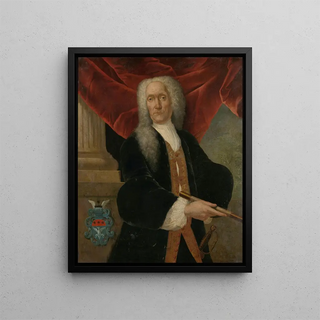Art print | Abraham Patras 1735-1737 - Theodorus Justinus Rheen


View from behind

Frame (optional)
Abraham Patras 1735-1737 - Theodorus Justinus Rheen – Captivating introduction
The work "Abraham Patras 1735-1737" by Theodorus Justinus Rheen immerses us in a universe where history and art intertwine with striking depth. This iconic piece, which evokes themes of mythology and spirituality, invites the viewer to attentive contemplation. Through its vibrant colors and meticulous details, Rheen manages to capture the very essence of his subjects, transporting us to a bygone era while resonating with contemporary emotions. The art print of this work allows a broader audience to access the richness of artistic heritage, offering a window into the baroque imagination that greatly influenced artists of his time.
Style and uniqueness of the work
Rheen's style is distinguished by impressive technical mastery and a keen sensitivity to nuances of light and shadow. In "Abraham Patras 1735-1737," each brushstroke seems to tell a story, each shadow an emotion. The artist uses striking contrasts to bring his characters to life, making them almost tangible. The drapery of clothing, facial expressions, and carefully crafted backgrounds testify to meticulous attention to detail. This work is not just a simple representation; it is a true immersion into an atmosphere charged with symbolism. This blend of realism and stylization gives the piece a depth that encourages interpretation and reflection.
The artist and his influence
Theodorus Justinus Rheen is an emblematic figure of baroque art, whose work marked his era with boldness and creativity. Raised in a rich artistic context, Rheen knew how to establish himself through his innovative approach and his commitment to faithful representation of human nature. His influence is felt not only through his creations but also by the way he inspired other artists to explore similar themes. Rheen navigated between tradition and modernity, integrating classical elements while experimenting with new techniques. His legacy endures, and "Abraham Patras 1735-1737" is a shining testament to this, illustrating

Matte finish

View from behind

Frame (optional)
Abraham Patras 1735-1737 - Theodorus Justinus Rheen – Captivating introduction
The work "Abraham Patras 1735-1737" by Theodorus Justinus Rheen immerses us in a universe where history and art intertwine with striking depth. This iconic piece, which evokes themes of mythology and spirituality, invites the viewer to attentive contemplation. Through its vibrant colors and meticulous details, Rheen manages to capture the very essence of his subjects, transporting us to a bygone era while resonating with contemporary emotions. The art print of this work allows a broader audience to access the richness of artistic heritage, offering a window into the baroque imagination that greatly influenced artists of his time.
Style and uniqueness of the work
Rheen's style is distinguished by impressive technical mastery and a keen sensitivity to nuances of light and shadow. In "Abraham Patras 1735-1737," each brushstroke seems to tell a story, each shadow an emotion. The artist uses striking contrasts to bring his characters to life, making them almost tangible. The drapery of clothing, facial expressions, and carefully crafted backgrounds testify to meticulous attention to detail. This work is not just a simple representation; it is a true immersion into an atmosphere charged with symbolism. This blend of realism and stylization gives the piece a depth that encourages interpretation and reflection.
The artist and his influence
Theodorus Justinus Rheen is an emblematic figure of baroque art, whose work marked his era with boldness and creativity. Raised in a rich artistic context, Rheen knew how to establish himself through his innovative approach and his commitment to faithful representation of human nature. His influence is felt not only through his creations but also by the way he inspired other artists to explore similar themes. Rheen navigated between tradition and modernity, integrating classical elements while experimenting with new techniques. His legacy endures, and "Abraham Patras 1735-1737" is a shining testament to this, illustrating






